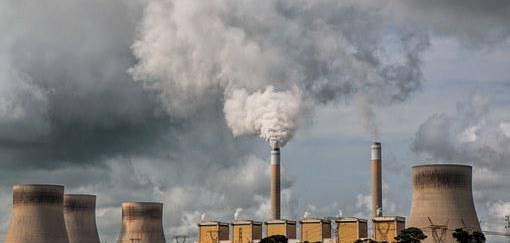
In 2021, the US raised its Paris climate pledge, committing to cut its greenhouse gas (GHG) emissions to 50-52% below 2005 levels by 2030. Yet questions remain about the actions needed to meet this target.
In an article published in Science, my co-authors and I apply six leading energy-economic models of US energy supply and demand, to identify pathways to reach this 2030 goal. Model intercomparison studies of this sort are used in fields such as climate science and energy modelling, to identify which findings are robust across models and input assumptions – and which differ.
Overall, we find robust agreement that there will be keys roles in meeting the 2030 target for low-carbon electricity and electrification – substituting electricity for fossil fuels in transport, buildings and industry. The models also align on the need for large-scale deployment of renewables, electric vehicles and other technologies, relative to historical levels and to scenarios where current policies continue.
Pathways for limiting warming to 1.5C generally involve roughly halving global carbon dioxide (CO2) emissions by 2030 and reaching net-zero CO2 emissions around 2050. This means that our study can be useful for other countries as they consider immediate action to mitigate emissions.
Emissions pathways by sector
Meeting the increased US ambition for 2030 would mean tripling the pace of historical GHG reductions in the country. With less than eight years left, what steps would need to be taken to meet this target?
We find that roughly 70-90% of emissions reductions by 2030 come from the power and transport sectors, shown by the purple and light green chunks in the figure below, respectively. These sectors are currently the largest emitters and have lower-cost mitigation options available.
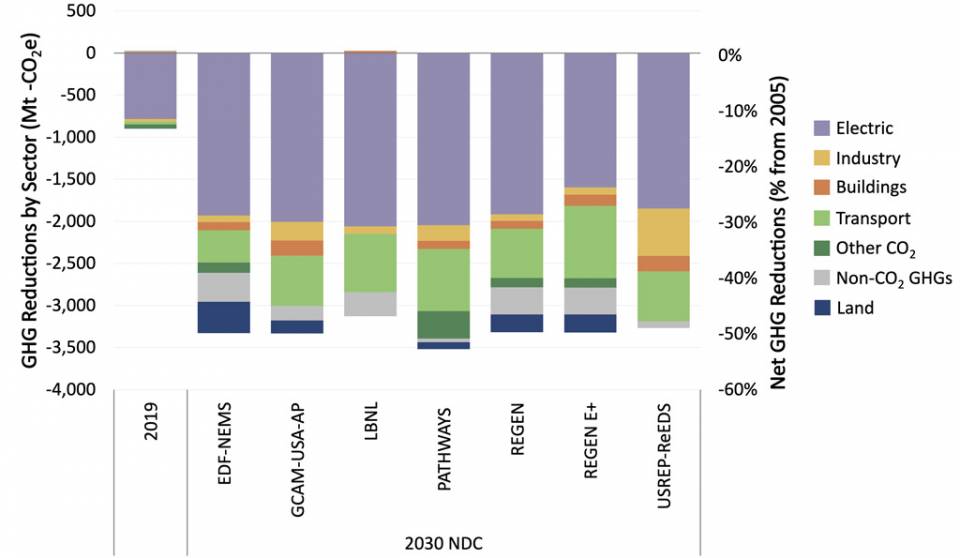 Comparison across models of US greenhouse gas emissions reductions in 2030 relative to 2005 levels. Historical emissions from US EPA’s Inventory of US Greenhouse Gas Emissions and Sinks. Source: Bistline, et al. (2022).
Comparison across models of US greenhouse gas emissions reductions in 2030 relative to 2005 levels. Historical emissions from US EPA’s Inventory of US Greenhouse Gas Emissions and Sinks. Source: Bistline, et al. (2022).
Despite this, all sectors still contribute to the 2030 target. Cutting emissions in half by 2030 requires all technology and policy arrows in the quiver. Energy efficiency, cleaner electricity and rapid electrification are central strategies for near- and long-term emissions reductions, our study found.
Immediate and sustained efforts are needed in several areas, which exceed recent trends:
- New wind and solar capacity increase two to seven times faster than the past 10 years. The largest annual deployment of wind and solar capacity to date was 2021 with 27 gigawatts (GW), but pathways to reach the 2030 target generally involve doubling or tripling the amount of renewable capacity built each year.
- Coal capacity retirements increase through 2030 and coal generation drops by 90-100% from current levels.
- Transport electrification adoption accelerates. Electric vehicles (EVs) increase from about 4% of new light-duty sales today to 34-100% by 2030, with an average across models of 67%. This exceeds the pace projected to occur with current policies (16-77% with a 38% average).
Power sector changes that have taken place over the past 10 years are shown in the leftmost column in the figure below, with annual average growth this decade in pathways meeting the 2030 target shown for each of the six models in the other columns. Notably, the rate of coal power capacity closures is consistent across all models, exceeding 20GW per year to 2030.
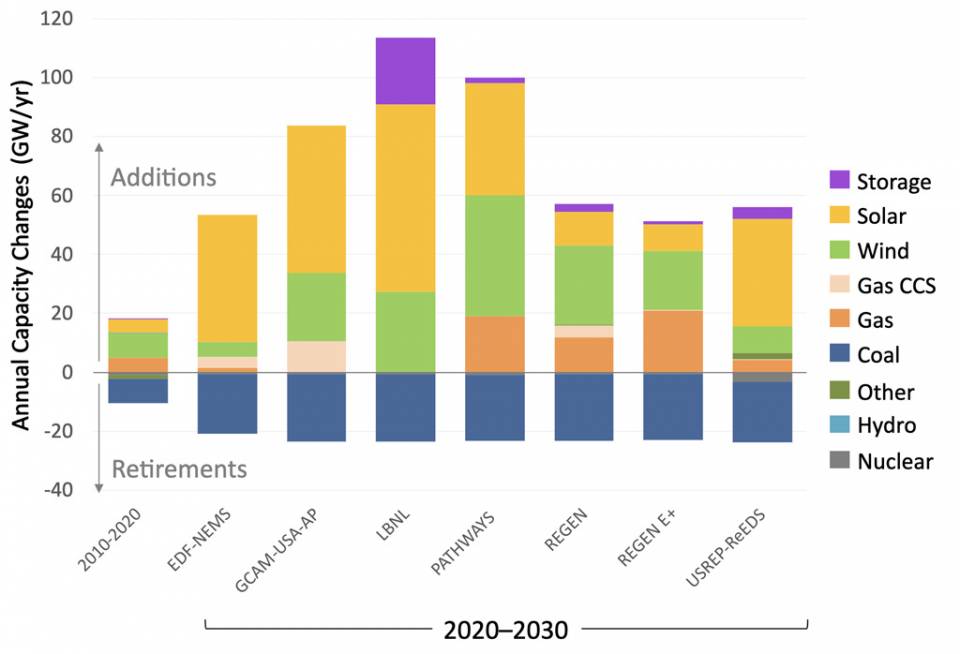 Cross-model comparison of average annual capacity additions and retirements by technology through 2030. Source: Adapted from Bistline, et al. (2022).
Cross-model comparison of average annual capacity additions and retirements by technology through 2030. Source: Adapted from Bistline, et al. (2022).
In the transport sector, the Biden administration set a 50% EV sales target by 2030, but our model results suggest that EV deployment may have to exceed that level to reach the economy-wide emissions target.
This is illustrated in the figure below, which compares historical EV adoption rates (yellow line) and in our six target-compliant pathways (brown lines), with the administration’s current 50% by 2030 target. On average, our models suggest current policies would lead to EV adoption reaching around 35% by 2030, whereas pathways meeting the overall 2030 climate goal entail an average adoption rate of 65%.
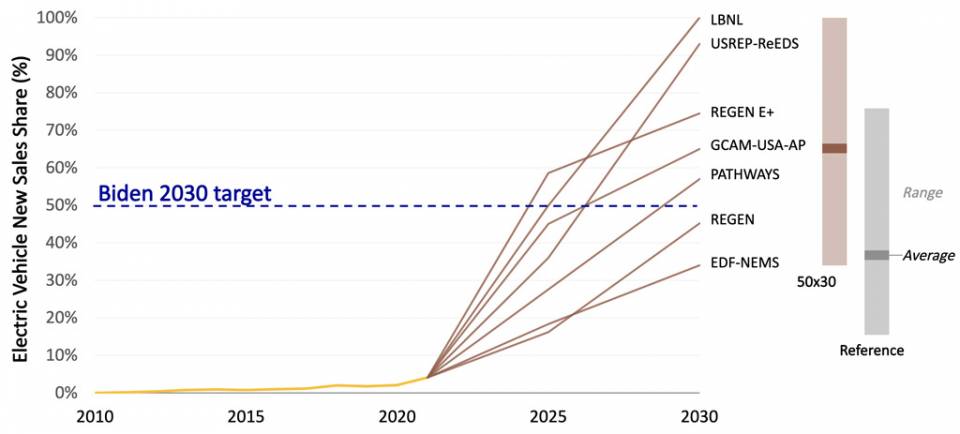 Comparison of electric vehicle sales share of US light-duty cars and trucks in 2030 across models. Historical values are from the International Energy Agency’s Global EV Outlook 2021. Source: Adapted from Bistline, et al. (2022).
Comparison of electric vehicle sales share of US light-duty cars and trucks in 2030 across models. Historical values are from the International Energy Agency’s Global EV Outlook 2021. Source: Adapted from Bistline, et al. (2022).
In addition to these broad similarities, there are several key differences across models. These include levels of electrification (and electricity demand growth), shares of wind and solar capacity, extent of new gas-fired power capacity and level of infrastructure deployment (such as electricity transmission networks).
The models also disagree about the role of carbon capture and storage (CCS), where three of six participating models deploy gas with CCS up to 70GW capacity by 2030. The models without CCS generally deploy more gas-fired capacity without CCS and energy storage.
Policy implications
Models agree that additional enabling policies are needed to facilitate the transition to meet the 2030 target. Comparing these scenarios against ones with current policies and technological trends reveals implementation gaps, which additional policies and incentives would need to close.
Existing climate policies are expected to lower energy-related CO2 by only 6-28% from 2005 levels by 2030, shown by the various columns in the figure below. This means those current policies would fall well short of reaching the 50-52% target for 2030 (horizontal line).
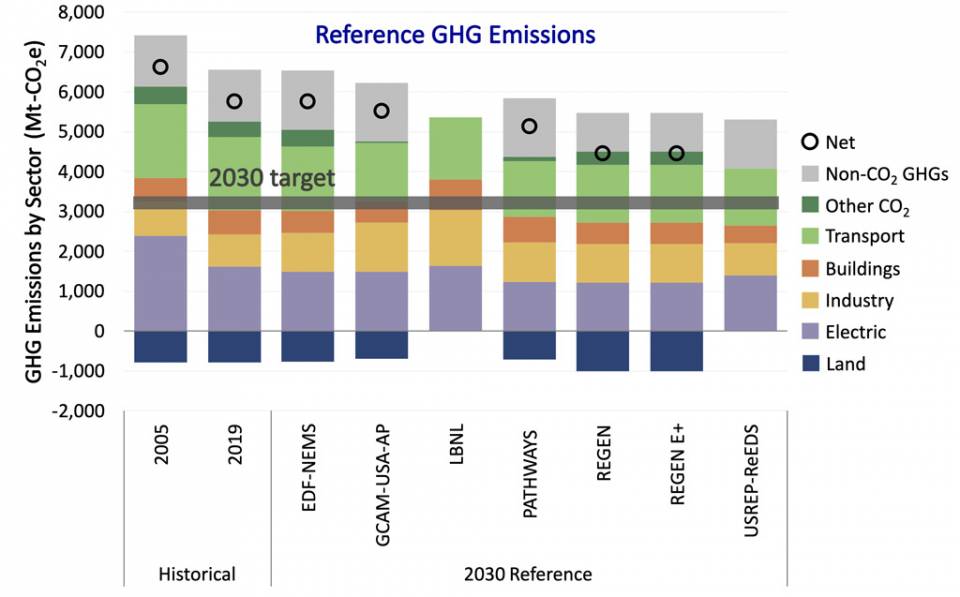 Cross-model comparison of 2030 US GHG emissions by sector in a reference (“current policies”) scenario. Source: Adapted from Bistline, et al. (2022).
Cross-model comparison of 2030 US GHG emissions by sector in a reference (“current policies”) scenario. Source: Adapted from Bistline, et al. (2022).
Models include different policies to close this gap. Some use bottom-up, sector-specific measures to mirror policy proposals, while others use top-down approaches to identify “least-cost” mitigation pathways using primarily an economy-wide GHG cap. Policies include clean energy tax credits, power sector standards, end-use equipment rebates, carbon pricing and combinations of these options.
Marginal costs of CO2 abatement, which equal the costs associated with the last tonne of CO2 reduced, range from $36-155 per tonne in 2030 across participating models. This broad range is due to differences in model assumptions about policies and technological costs.
Although questions remain about which policies and incentives are politically attractive and durable, these scenarios illustrate that many different combinations of policies could be used by policymakers to halve emissions by 2030.
The US Senate is currently debating over $500bn in tax credits for renewables, EVs and low-emissions technologies, but the fate of these incentives – and how close they come to narrowing the 2030 emissions gap – remain uncertain.
Benefits and costs
Actions to meet the 2030 goal generate a range of benefits. Avoided global climate damages from these policies are estimated by one participating model at roughly $140bn per year. There are also co-benefits of localised reductions in air pollutants, such as sulphur dioxide, nitrogen oxides and particulate matter, which can have significant and immediate benefits for human health.
Other benefits could include creating jobs, boosting innovation, increasing international competitiveness and improving equity outcomes for low-income households – all factors that depend on policy implementation details.
In terms of policy costs, models can calculate increases in energy system expenditures to reach the 2030 target (including spending on fuels, maintenance and capital costs of supply- and demand-side technologies) relative to reference levels without these policies.
These incremental costs are $90bn-280bn per year by 2030, though technological progress in renewables and EVs have substantially reduced these decarbonisation costs, even compared with a few years ago.
Next steps
Our article shows that the next steps in reaching the 2030 US climate target are clearer and increasingly affordable, but require new supporting policies to get there. Actions to reach this goal likely involve widespread deployment of existing technologies, which take advantage of technological change and associated policies from earlier periods.
The large and rapid buildouts of resources, exceeding levels in the recent past, suggest that institutional innovation could be required to increase adoption at a faster pace, including accelerated siting and permitting of low-emitting projects.
Our study provides more detailed projections, actionable insights and greater confidence about the policies and technology deployment needed to achieve near-term climate goals. These actions can lay the groundwork for an affordable, reliable and equitable clean energy transition.
Written by :
John Bistline - program manager in the Energy Systems and Climate Analysis group at the Electric Power Research Institute (EPRI).
Sources :
Posted on 2022-06-13 10:11









Comments